Not quite as gross as I expected it to be.
One of the things about living in farm country is that there are a lot of farmers around. I’m not just talking about the folks who grow corn or soybeans or even the cherry trees that originally brought me here in 2008. I’m also talking about people who raise cows and chickens for milk and eggs and meat.
I ran into an acquaintance at the local Coastal Farm and Ranch store about a month ago. I was looking for a chicken fencing; he was buying a ton of feed for meat chickens. We chatted about our chickens, ending up with an offer to buy some freshly slaughtered birds the next time they killed. I ran into him and his spouse again a week later and placed my order for two birds — which is about all I can fit in my RV’s tiny freezer. I asked if I could come watch them slaughter the chickens and was told I could. I wasn’t sure how I felt about it, but I suspected it would be, at the least, very interesting to see.
I was invited to their next slaughter, but had to turn down the invitation because of a scheduling conflict. (I spent that day in Woodinville, wine tasting with a hard cider maker friend. I really need to blog about that excellent day.) But they slaughtered again on Saturday morning and I made it my business to attend.
First came a tour of the facilities. The birds live in a relatively spacious pen beneath a deck. All my non-farming friends talk about “free range” — this is about as free as these birds want to be. They basically do four things: eat, poop, sit, and sleep. They are not interested at all in wandering around, pecking at the ground and doing bird things.
This could be because of selected breeding. Meat chickens are bred to grow quickly. The birds in the pen were 6 to 8 weeks old and ready to slaughter. They were huge — far bigger than my 7 week old laying chickens — and downright lazy. They just sat around in the shade and seemed perfectly happy about it. Melanie, who’d invited me that day, said that if they don’t slaughter them now, they’d likely die of heart attacks within the next few days. She’d already lost two of them that week. These chickens are not bred for longevity.
We talked about “free range” and she confirmed what someone else had told me: if given access to a large open area, these chickens would do the same thing they were doing right then: nothing. It would be a waste of space. They’d tried it and had seen for themselves.
I can actually confirm a bit of this. My 7 laying chickens have a 9 x 25 enclosure and they spend most of their time either in their coop or in the shade of some straw bales stacked up outside their yard.
Melanie gave me a quick rundown of the process. Rather than just narrate, why not look at the photos I took and read the captions?
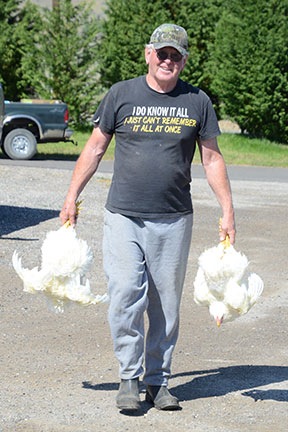
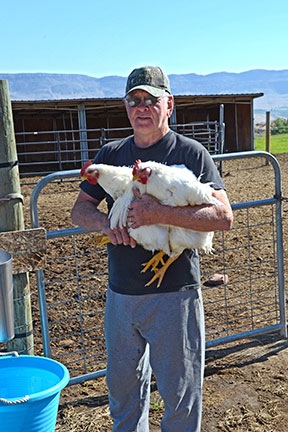
Al was in charge of fetching the chickens from the pen. He took one or two at a time. He said he talked softly to them as he caught and carried them, telling him that he was sorry but that they were going to taste good. And before anyone freaks out about him carrying them by their feet, that’s actually how it’s supposed to be done to calm them down.
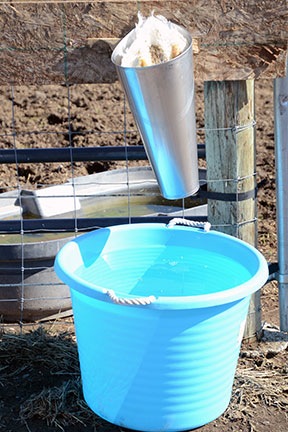

Al placed each chicken head down in what’s commonly known as a killing cone suspended over a large basin of water. After a few minutes, the chicken relaxes enough to let its head through the bottom of the cone.
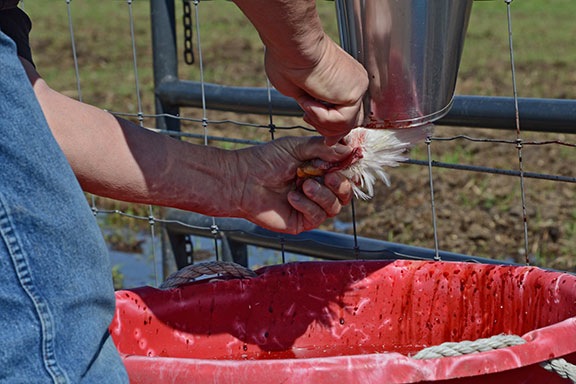
Next, Dennis stepped up with a very sharp knift, grabbed the chicken’s head, and slit its throat.
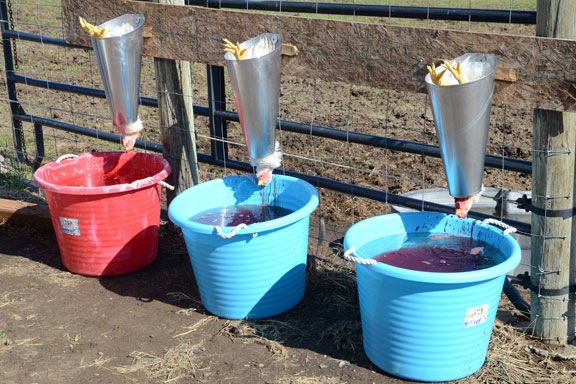
The blood drained from the chickens into the bins of water. Although the chickens died very quickly — this is supposedly the most humane way to do this — they often had muscle spasms that made them jerk around inside the cones. That was probably the worst part of this whole thing — seeing those dead chickens move as the blood drained from them.

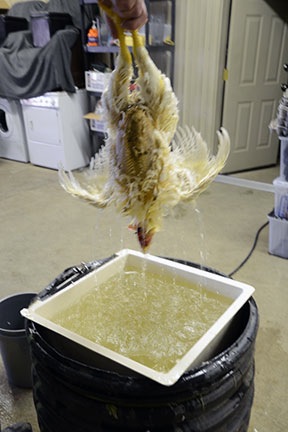
When the chickens stopped moving and the blood had sufficiently drained, Al took them, one at a time, to a vat of very hot water to loosen the bird’s feathers. The water had to be an exact temperature: too hot and the skin would split when the feathers were plucked; too cool and the feathers wouldn’t come off. He dunked each bird 3 times, swirling it around in the water before taking it back outside.
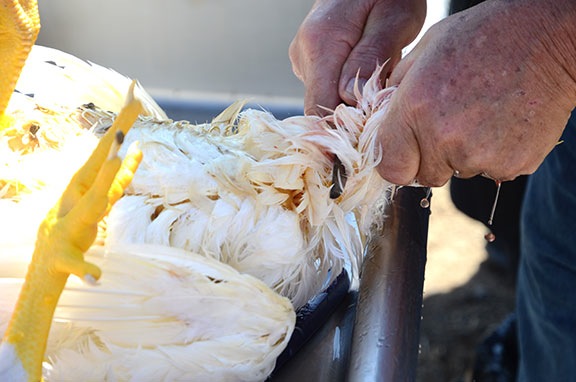
Back at the butchering table, Dennis used his sharp knife to cut off the chicken’s head.
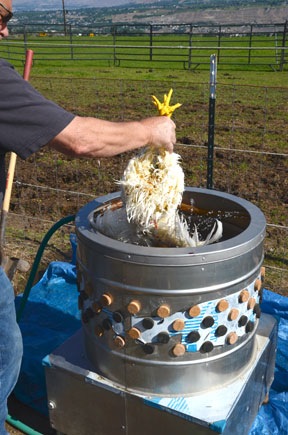

Then Dennis dropped the bird into the chicken plucker and turned it on. This machine has a bunch of rubber-covered fingers that pull the feathers off the bird as it bounces around inside. The process takes less than 10 seconds and splashes quite a bit, so I couldn’t get a decent photo of it.

The chickens emerge with only a few feathers left, all ready to be butchered.

Jill and her husband did the butchering, using sharp knifes and cutting boards on a stainless steel restaurant sink. The feet are cut off first.
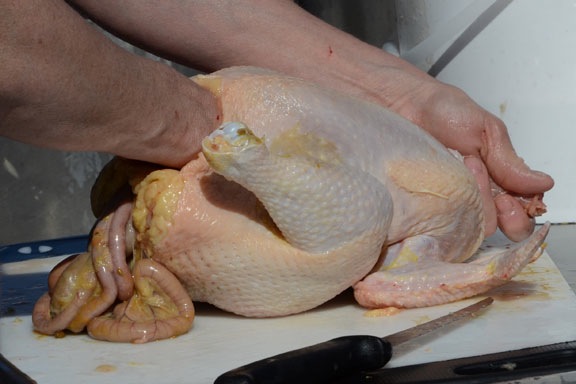
Next, they open up the chicken’s bottom end, reach inside, and scoop out the innards. (This part is pretty gross.)

They saved the hearts and gizzards — for the dogs, I think — but threw away the rest of the guts, including some really excellent livers that my mother-in-law would have killed for. (People outside of the NYC area don’t seem interested in chicken livers.)
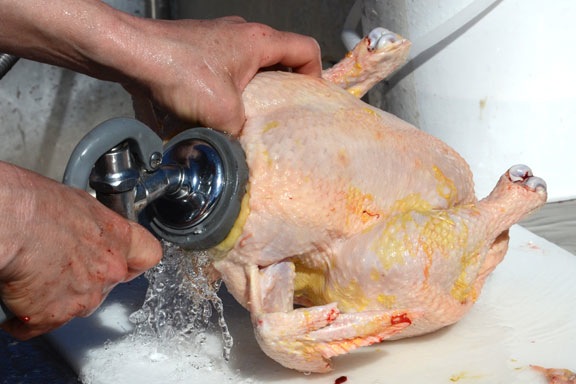
There was lots of washing with fresh, cold water. Afterwards, the chicken was put into a large plastic container filled with ice water. It stayed there for about 15 minutes before being transferred to another plastic bin of ice water.
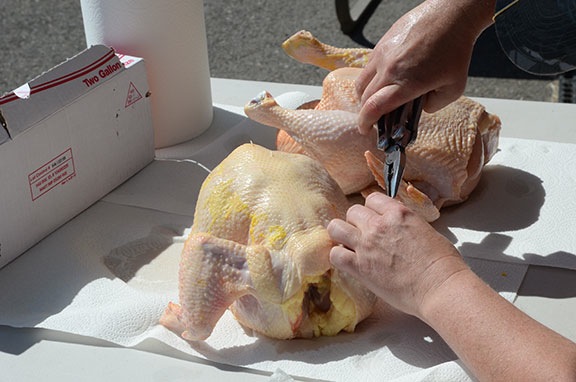
Melanie’s job was to pull off any remaining feathers and exterior fat, pat the chickens dry, and then vacuum seal it. From there, it went right into a freezer.
We started work at about 9:30 AM and, when I left at about noon, 25 birds had been slaughtered. Melanie was almost done packaging them. It was a lot of work.
I got to take home one fresh bird and one frozen one from the last slaughter. I cooked up the fresh one on my Traeger grill and it was good — although I have to admit that it wasn’t quite as good as I expected.
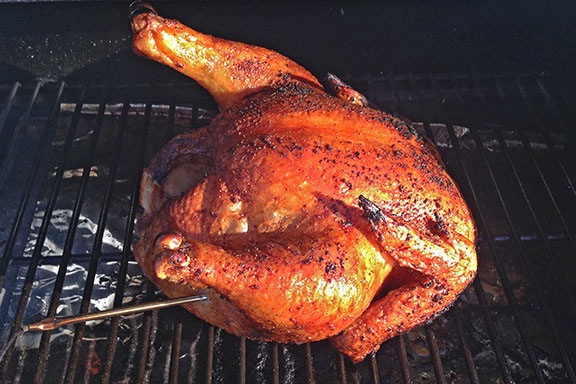
Looks yummy, no?
It tasted like chicken.
Would I do this again? I can’t see any reason to. And although I might buy chickens from Melanie and company in the future — mostly to support local farmers — I don’t think I’d stop buying store-bought chickens.
Discover more from An Eclectic Mind
Subscribe to get the latest posts sent to your email.

We needed more insect control in the orchard and added meat chickens this year. We are raising a heritage breed and not the Cornish Cross. Takes longer, but the costs aren’t much more because they will chase a bug, eat greenery, act like they aren’t too stupid to come in out of the rain. They might get tough if they get too old, but they won’t keel over at 8 weeks. Our first big slaughter day is going to be early July – the basin of water idea is a good one I hadn’t seen elsewhere.
When you realize that birds bred to grow fast and be slaughtered young aren’t very active, it doesn’t make commercial poultry farming look so inhumane. I’m not saying that the tiny cages are humane — I’m just saying that they aren’t as cruel as some people think. It’s almost as if they’re not really animals. Weird.
The local inspectors let you keep livestock in your orchard? That’s strictly verboten here, even in organic orchards. A friend had goats in his organic cherry orchard to keep the weeds down and he was told to get them out. Such as shame when you consider the fertilizer potential.
When I was a kid I learned how to kill chickens, as we raised them for eggs and meat. I learned first hand where the phrase “running around like a chicken with it’s head cut off” comes from. The whole while with wings flapping like crazy. Blood everywhere. Wish we knew about the cones. Dad and I would do the dirty deed, mom would pluck and we had chicken for dinner. Free range? Well the chickens had the run of the yard. It was quick for the chicken. Not so much for us. Just part of growing up for me. You’ll get the hang of it Maria, and save a few bucks if you have some time on your hands (which you apparently don’t have a lot of right now). Great blog! Thanks.
Thanks for the story. But I don’t think I’ll ever be able to slaughter my own chickens.
Just did my first one today! Boy was it messy, but pretty quick and painless. I just skinned her because I don’t a something else to pluck the chicken for me. But that chicken cone sure makes that part of the ordeal much easier. I will definitely be purchasing one of those for the next slaughtered chicken.
You’re way braver than I am. I’d rather watch and assist once the blood and guts are done!